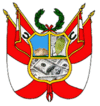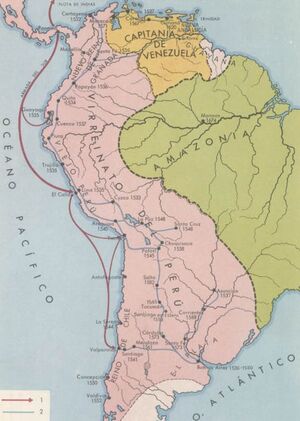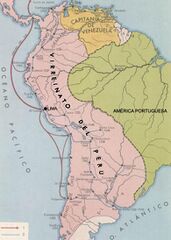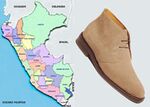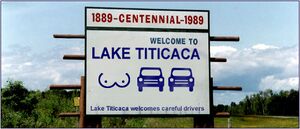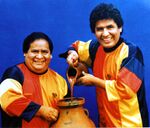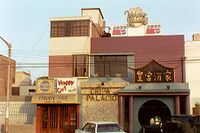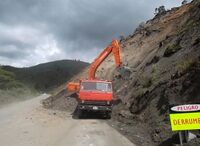Peru
Republic of Peru Republic of Lima and Other Unknown Territories Peru | |||||
|---|---|---|---|---|---|
| |||||
| Motto: "Disculpa, No Hay" | |||||
| Anthem: Pollada´s sorrow, El especial del Humor opening song, El pio pio | |||||
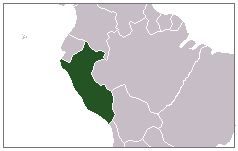 | |||||
| Capital | Lima | ||||
| Largest city | Lima | ||||
| Official language(s) | Spanish, Spanglish, Ah Yungayish, Conchatumarish and Japanese (briefly in the 1990s) | ||||
| Government | Inca, Patriarcal | ||||
| National hero(es) | Jaime Bayly, Seleccion de Futbol, Ceviche, Super Cholo | ||||
| Currency | The Luca (AKA Lucrecia or Solano) | ||||
| Religion | Adoration of the Sun, surf, football and Alan García | ||||
| Major exports | Drugs, Potatoes | ||||
| Major imports | Drugs, Japanese People | ||||
Peru is a small but cheerful nation located in a jolly neighborhood, which has never had any serious disputes with any of its neighbors, Colombia, Ecuador, and the magical twin brothers, Chile and Bolivia; and surely not with gigantic Brasil.
History[edit]
In the beginning[edit]
In the beginning, fire was discovered by Matchsticci Viracocha ("Fósforo" Viracocha in the ancient Peruvian language), after whom the Sun was named.
Bigots say Macchu Picchu was built by aliens because they don't think Native Americans could ever build such a monumental, luxurious city. This is how all these silly theories on the Incas being descendants from space aliens began. If this were true, it would be the Protoss.
The Incas started their (kinda short-lived) rule in a territory filled with anything one could wish for: gold, silver, bronze, adamantium, platinum, steel, molybdenum, and lots and lots of other metals, and seriously weird animals (though they mistook Pikachus and named them Vizcachas). From this wealthy condition, the successors of Pacha Cutie-Pie (Tupac One Inca, Tupac Two Inca, Tupac Two Million Inti, and Juaña Capac) gradually took over all Peru and expanded their rule from Southwest Colombia to Central Chile and from the Pacific Ocean to the borders of the Great Chaco — until something evil arrived.
Toponym[edit]
Peru was named by the Incas of Guajira Peninsula in Colombia, who were governed by the Chinchas. They were Chincha Alta and Chincha Baja (High and Low Chincha), sort of a swarthy Laurel and Hardy.
When invaders drew their swords and politely asked the Chinchas where they could find gold and silver, the Chinchas said there wasn't any in Colombia but there was an awful lot of it several miles south, in a place called Piru, which was by a river called Viru. The Chinchas didn't know any Piru or Viru; they just made that nonsense up to get the invaders to invade something else. They would go on to spell their name Chibcha, to throw the conquistadores further off the track.
Years later, Piru was identified as Macchu Picchu. The River Viru must have been the Ucayali, probably. The Incan Empire the invaders sought so desperately was this nation of Peru, and the basis for Peruvian commerce was established: eagerness to give the visitor detailed information, coupled with complete disregard for whether the information is true.
Sliced and diced[edit]
When Huayna Capac was writing his Will, he decided the Inca Empire was so large and wealthy it should be divided between his two sons Atahualpa and Huáscar. The Northern half, with its capital in Quito, was left for Atahualpa, and the Southern half, with its capital in Macchu-Picchu, was left for Huáscar. However, soon after Huayna Capac's death, greedy Atahualpa killed his own brother and his nephews and took everything for himself.
The High Priest of Viracocha announced that this treachery would bring a terrible curse on the Incas and Peru. Indeed, just a few years later, while the ancient Peruvians were squabbling over the exact boundary, huge Galleons appeared from over the horizon, carrying rape, murder, slavery, new diseases, and finally, Catholicism.
After mere centuries of occupation, Spain was defeated by Toledo Skywalker. Then, setting the fashion that many future Peruvian leaders would follow when things get hot, he just ran off to Europe. Peruvians got a chance to replace the Spaniards' murder, tyranny, and strife with stuff they could call their own.
Pisco War[edit]
The Pisco War was not about sour cocktails. It is also called the Pacific War, but it wasn't peaceful either. Rather, two brother countries fought over the tips that Dad left them. Peru vanquished the cabros, as they affectionately refer to Chileans. Tourists who wish to explore this era can travel to the Peruvian military museum in Arica, after a short stop at Chilean customs.
Recent years[edit]
Peru is the only country where a woman can get elected to Congress just by flashing her butt with her ballot number painted on it. Peruvian presidents have not just manipulated the constitution, they have asked it out, slipped it a roofie, and raped it. The latest Peruvian presidents have been:
- Alberto Fujimori (called "The Last Samurai," mostly by himself). He became famous with his slogan Yuca Pa' Tí. "Yuca for you." Yuca would be the tasty cassava root, of which there was never a shortage anywhere in Peru. But voters did not realize that the root would wind up shoved up their asses.
Fujimori quickly routed the Sendero Luminoso terrorists, much as your new security guard catches a burglar on his first night at work (which turns out to be the brother he paid to play the role). Fujimori finished cleaning up the country--to prepare for its sale to his cronies. A shiny new constitution provided for a single presidential term. Plus a brand new legislature that voted that the single presidential term obviously didn't apply to the President. (This law was called Authentic Interpretation.) When "personal consultant" Vladimir Montesinos put his treachery on videotape, Fujimori resigned--by sending a fax--and moved to Japan, not because he is from Japan, but because of the difficulty of extradition. - But difficult doesn't mean impossible, and Fuji was succeeded by the caretaker president Paniagua, whose name (bread-and-water) is actually more apt for Fuji, now rotting in a small jail in the sierra for
2531 years.[1] However, lest you think justice prevails in Peru--
Alejandro Toledo Skywalker de Karp (self-proclaimed last surviving Inca of the empire and first Peruvian indigenous president). He is famous for having children outside marriage, marrying a Belgian red-headed trans-sexual, making his personal witch doctor the ambassador to Nicaragua, and placing his numerous family in strategic positions, such as 69.“Soy un cholo gitano que va trotando por el mundo ("I am a gypsy highlander jogging around the world")”
And if he merely returns to Peru, he can take his turn serving 18 months in jail, the same number as the bribes he took from Odebrecht, allegedly. Officials say 18 months should be long enough for prosecutors to build a case against him. The bribes were to ensure the construction of the Interoceanic Highway, but the story is preposterous on its face, as Peru has frontage on only one ocean. However, Toledo cannot double up with his predecessor in the sierra and while away their days discussing statecraft, as that facility does not have bunk beds but humble stone slabs.- Alan García, a man who doesn’t know that 2+2 is 4. García was President once before; the government took over everything and sucked so much value out that he had to create a new currency worth 1000 of the old one. And then do it again, so 2+2 was indeed not 4; 4 billion was 4.[2] He fled to live in Paris, then came back to say I'm sorry--and Peruvians elected him again. That Peruvians forget the political betrayals of the 1980s is not surprising, as they often forget those of the last week.
- Ollanta Humala vaulted to power in 2011 on the inspiring slogan, "My name is not Fujimori." On the unstated corollary--that he is also not Hugo Chávez--the jury is still out. Humala's desire for closer ties with the Soviet Union has been impeded by the fact that it is as far into rigor mortis as Hugo is. He disappointed the nation by announcing he would not try to find a way around the constitution to run for re-election.
- Pedro Pablo Kuczynski was elected in 2016, one of a panoply of candidates for President using the inspiring slogan, "My name is not Fujimori either," requiring a run-off election between the top two. Here, only Kuczynski could credibly make the claim, especially because no self-respecting Spanish-speaker could figure out what his name was. His candidacy was helped by the fact that First Daughter Keiko Fujimori was suddenly right wing.
Modern Peru[edit]
The national territory[edit]
As the map (left) shows, the Viceroyalty of Peru used to comprise all of Spanish South America. That ancient land relates to the modern-day Republic of Peru (right) in about the same way as that party-size pizza you ordered relates to what you will have left over, once the neighbors find out you are having a pollada (a block party with free food) and come to visit.
The territorial extent of Peru is a touchy issue with Peruvians, although they will tell you that size does not matter. The border on all sides has been the subject of squabbles and wars, and is currently set by a treaty arbitrated by Guarantor Nations: Narnia, Atlantis, Vulcan, and The Shire. The border remains fluid, as neighboring countries admire Peru in all things, except perhaps prowess at war. Arica is an example of a fine Peruvian city you can visit by vacationing in Chile.
President Fujimori angered his constituents when he transferred a symbolic one-square-kilometer stretch of jungle to Ecuador. Lugging a cast-iron tub to the disputed territory, and taking a bath for the cameras, formalized the deal and promised a new era of cross-border commerce in plumbing fixtures. Fuji also gave Bolivia 403 acres in Ilo with frontage on the Pacific Ocean. What a guy. "Boliviamar" is now one of Peru's more picturesque vacant lots. Bolivia still wants a sovereign corridor to the ocean. (Hint: Don't lose the next war.) And Ecuador, for some reason, still wants a corridor to the Amazon. Peru has the only corridor it wants--direct flights to Miami and Los Angeles.
The border with Bolivia runs across Lake Titicaca, the world's highest navigable lake. "But we got the titi, and they got the caca."
The language barrier[edit]
“Oh Ricky, you're so fine, you're so fine you blow my mind”
The immigration form you fill out before your plane lands is the first hint you are going where enthusiasm about English runs way ahead of ability. The form reminds you that sneaking in a laptop will be viewed "smuggly." (In fact, you can declare it, but failure to take it out when you leave--or having it get stolen--requires you to pay customs officials its full price, as determined by them. You can negotiate...but your plane is getting ready to leave.) The spotty command of English is again evident in the shopping centers of Lima: You will hear pop music never played back home because the lyrics are too stupid. But they don't know that. Peru is a Top-40 Jukebox from Hell.
The Maginot Line on this language barrier is the Peruvian dialect of Spanish. As Eskimos have dozens of words for snow, Peruvians have a variety of choices when talking about getting drunk and defecating. Peruvian Spanish includes several national obscenities that sound just like ordinary words in non-Peruvian Spanish. This lets Peruvians amuse themselves by tripping up tourists.
The money[edit]
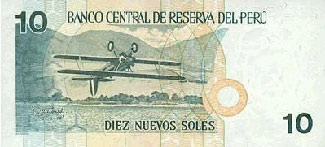
“Worry you must not, lend you I will.”
The currency is the nuevo sol (new sun), which is 1 billion old suns. The sol held pretty steady at about 3 to the dollar through García's curtain call in the Presidency, surprising no one more than García. However, no one trusts this to last, and anything as big as a refrigerator or requiring time payments is priced in dollars. The "tributary unit" for government fines is expressed in the local money; it's just constantly adjusted to be some number of dollars. Likewise the going rate for a hooker.
To exchange dollars, just go to San Isidro and look for a man holding up a calculator. (A government official denied that Peru was in recession; he saw calculator vendors on every corner.)
Ten soles is written S/.10--You can think of that as a percent sign, where someone stole the circles and left a rock in place of one of them.
Cuisine[edit]
“El ají pica dos veces”

Peru is a place where bologna and saltines are foreign delicacies. The national dish is ceviche, and if yours arrives cold, do not send it back; the only problem is your expectation. Peruvian cuisine features a variety of sauces, which are essentially different flavors of mayonnaise, to dip stuff in. Some sauces are thickened by crumbling up Ritz crackers in them.
If your order comes with what looks like a tomato or carrot garnish, discreetly lift it off and set it aside, or you will be sorry late tomorrow.
And chicha morada is a thing that, like sausages and legislation, you may enjoy but don't want to watch being made. In fact, you might want to learn how your batch was made before you enjoy it at all.
Peruvians are fiercely proud to drink Inca Kola, the fizzy drink that tastes like bubblegum and looks like piss, instead of Coke and Pepsi, those tokens of American beverage imperialism, blissfully unaware that the business was sold to Coca-Cola in 1999.
The myth that Peru is part of Brazil[edit]
Peru is small, but in fact it is more than just a region of gigantic Brazil. In Brazil they speak Portuguese, and they have Ronaldiños and Peles. Peruvians speak Spanish (ignoring Portuguese-like persons named "Leao" or "Mariño") and have Chumpitazes and Nenes (which are arguably as good).
Both nations have happy jungles (from cocaine and marijuana production), happy coasts (from consumption of the same), and short, whimsical names for things. However, while Brazil has won the World Cup 5 times, Peru has gotten to go to the World Cup about 5 times. While Brazil only has wild parties and other hidden secrets as its international attraction, Peru has old buildings, old cities, old customs, and other old (and usually stupid) things that tourists somehow pay to see. Finally, Brazilians don't drink as much as Peruvians do. Brazilians love the idea that they have a Peruvian at their backs.
Regions[edit]
Peru has lots of big, long, thick, bushy trees in the jungle, and very deep craters in the mountains.
Cities[edit]
People live in boxes of orange bricks or in straw houses. Their diet consists mainly of corn, llama cheese, potatoes, Cheetos, and cuy (guinea pig), which may be deep-fried, roasted, or sauteed.
Lima[edit]
Lima is the capital and largest city of Peru. Lima is a city of wonder, with polladas (crowded neighborhood parties), good cheap cocaine, and labor strikes over anything.
Arequipa[edit]
This large city in the Southwest is also called "the White City." This can mean only two things: Gringos and guano. Both have accumulated on the main plaza and most of the churches. The only thing Arequipeños love more than spicy food, and of course themselves, is arguing into the night with anyone over anything.
Cuzco[edit]
If you are a tourist and want to tell all your friends at home you have been to Peru, or show them slides of your trip, you had better visit El Cuzco because that is what they all think Peru is. If you showed them a slide of, say Polvos Azules, they might ask if your plane was forced to land in Mexico City instead.
Chiclayo[edit]
Chiclayans live in pyramids made of clay and straw. These "recyclable" houses have to be rebuilt following every year with a strong El Niño weather pattern. In these years, Chiclayo becomes known as "Peru's island paradise" because intermittent lakes in the desert flood the Panamerican Highway in both directions. The residents are friendly, but they have to be, because there is so often no way out.
Trujillo[edit]
Trujillo is called the "Spring City"--even though its weather is wintry--and Peru's Second City (conveniently ignoring Arequipa). Trujillo has a lot of good places, like Huanchaco, a nearby beach where fishermen surf. Their principal catch is the white chicks on the beach.
Cochabamba[edit]
Cochabamba is not in Peru. It is in Bolivia. But Coche-bomba (car-bomb) has been in several places in Peru. This is why friendly Mr. Serenazgo will be searching the trunk of your car when you enter the supermarket parking lot.
Eastern regions[edit]
Peruvians who live away from the coast speak in God-awful dialects. This might be caused by consuming monkey, turtle, alligator, and other yummies.
The Andes[edit]
White people call the Andes "the mountains," delicate white people call them "the highlands," and Peruvians call it the sierra. Picturesque, steep slopes rise above villages and the national highways. Except twice a month, when one of them becomes a gentle slope covering villages and the national highways. The townspeople gather at the site of these huaycos to talk about them, vehicle traffic backs up beyond sight and no one knows why, and everyone waits three days for the steam-shovels to come up from Lima. Happily, these disruptions do not affect the economic statistics of the region.
Jungle[edit]
The jungle beyond the Andes is the enigmatic selva. The typical occupation is waiting for lunch to fall out of trees. The selváticos bring the same high level of energy to their employment. If a city-dweller calls you a selvático even though you don't live in the selva, relax; it is merely an insult.
Outside[edit]
You can find Peruvians not just in Peru but in "enclaves" in every other country. Expatriate Peruvians keep busy by touting the benefits of living in Peru, as though there were no reason for them to have left; keeping current on Peruvian news, and voting both in Peru and in their adopted countries.
Peruvians living in the United States reminisce about Peru while behind the wheel. They like to pretend they are back in a place where there are no lanes marked on the pavement, and where shaking your hand out your window before you cut someone off is the mark of a gentleman.
See also[edit]
Footnotes[edit]
| ||||||||

